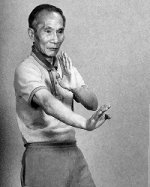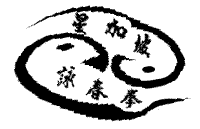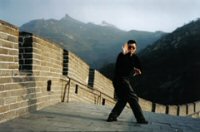
All Classes Full!
Watch this Space For Future Updates!
Simplicity is the key in Wing Chun

"Yip Man has said that with Kung Fu, the simpler, the better, Yip Man tried to further simplify Wing Chun but was unsuccessful. If Wing Chun can be further simplified without losing skill, it will take the art to a higher level!"
Grandmaster Ip Chun
Sticking Hands
The "heart" of Wing Chun system is the "Chi Sau" (Sticking Hand), which is a conditioned reflex training exercise with a partner to develop sensitivities of the arms, enabling you to control and predict your opponent's movements.
It is as much a game of cunning and intelligence as it is a physical challenge.
Chi Sau serves as a bridge between the first stage of the learning process; acquiring concept and technique and the second stage; putting them into practice and the third stage; being able to use them in combat.
It provides a platform upon which the practitioner can safely develop their abilities and test the abilities of others.
At its more advanced level, a Wing Chun expert can even be blindfolded and defend himself effectively as soon as he comes into contact with his opponent's hands.
Secrets in Wing Chun
The secrets in Wing Chun are hard work, perseverance and lots of sweat! Acquire & emulate the skills, practice diligently to expand the knowledge, dissimulate so that it becomes part of you!
Health and Wing Chun
Every knows Wing Chun is a effective combat art and good for self defense, but rarely mention is that Wing Chun can also helps to improve general health and de- stresses the mind!
What is Wing Chun Kung Fu?
"Simple yet effective, a no-nonsense martial art system developed for practical street survival."
Wing Chun is one of the most notable, effective and functional Southern Chinese martial art systems available today.
The principle of Wing Chun is simple: to stop the enemy using the most direct and economical means possible.
This means any "flowery" or complicated maneuvers or wasted motion that are not directly applicable to combat are left out. Grace and elegance have no importance in Wing Chun.
It is the very same system that the famous actor/martial artist, the late Bruce Lee trained and used as the foundation for his own style JKD!
Also many military & law enforcement agencies around the world such as the US Navy Seal, the FBI, the French RAID and the German SEK unit etc. have all adopted Wing Chun's practical fighting element as part of their unarmed combat training simply because it works in the field!
Characteristics of Wing Chun
Wing Chun's practical success lies in its simplicity and its fighting principles. Emphasis on utilizing position, angling, body mechanic, knowledge in use of energy, etc. to neutralize attacks rather then rely on power and size. This makes it especially suitable for women and people of small stature.
Simultaneous attack and defence, instantaneous reflex attack when opponent's hand disengages; narrow stance, agile footwork, economy of movement, straight line punch along the shortest distance between two points, explosive power generated at very short distances like that of a coiled spring when released, but without tension, low kicks that rarely go above the waist; often felt and not seen! These are typical characteristics of Wing Chun in the world.

Ven. Lama Dondrup Dorje Demonstrate Wing Chun's Classic Simultaneous Attack & Defense
The System
Unlike many other Kung Fu styles, which have numerous empty hand forms, the Wing Chun system has only three.
The first form "Siu Nim Tau" (Little Idea Form) teaches the foundation of the system including the "centreline" concept, basic hand techniques and energy training that define Wing Chun.
The second form "Chum Kiu" (Bridge Seeking Form) teaches how to bridge the gap between practitioner and his opponents i.e. to seek arm contact & intercept an attack using body shifting and footwork.
The third form "Biu Tze" (Thrusting Fingers Form) teaches how to recover the "centreline", the long and short range of attack, defence using fingers rather than the fist as the name indicates.
Apparatus and weapons training in the system include the "Muk Yan Chong" (Wooden Dummy Form), the "Bart Cham Dao"(Eight Cutting Knives Form) and the "Luk Dim Boon Kwun"(Six and a Half Point Long Pole Form).
Upcoming Events: Master Class Seminar :
Classical Tajji Meditative Qigong 29th, 30th June & 1st July 2009 7pm @ SAFRA Toa Payoh
The Institute of higher learning for Classical Internal Arts studies.
Did you know?
The term Kung Fu or Gung Fu (Mandarin pronunciation) has become synonymous with Chinese martial arts; originally it used to refer to any skill or ability that had been developed through persistent effort over time and is identified with expert or sage.
This is appropriate in the sense that the mastery of Kung Fu requires considerable time, energy, strength, and most of all determination. So next time when you turn up for your martial art class be prepared to sweat, and yes it will takes years to perfect!
Wooden Dummy
Wooden Dummy or Chong traditionally refer to a pole or stake partly embedded in the ground used in martial art practice. Various configurations existed including the triangular Chong for kicking; plum blossom Chong for balance etc.
Most of the Wing Chun Chong you see today will be the indoor suspended type, either wall mounted or free standing. The Wing Chun Chong consists of a main trunk, two upper arms, one middle arm and a leg representing a human form.
The Chong is the best substitute to a live training partner which enable the Wing Chun practitioner to fine tune his techniques and to understand proper body alignment, stance, positioning, fluency, control, dissipation of energy etc. and the best part it’s available 24/7/365!!

Sifu Ken & his Muk Yan Chong

This website is designed and constructed by © Ken Lau 2001-2009.
For general feedback or enquiries, please email to wingchun_sg@yahoo.com.
Updated on 9 Feb 2009
